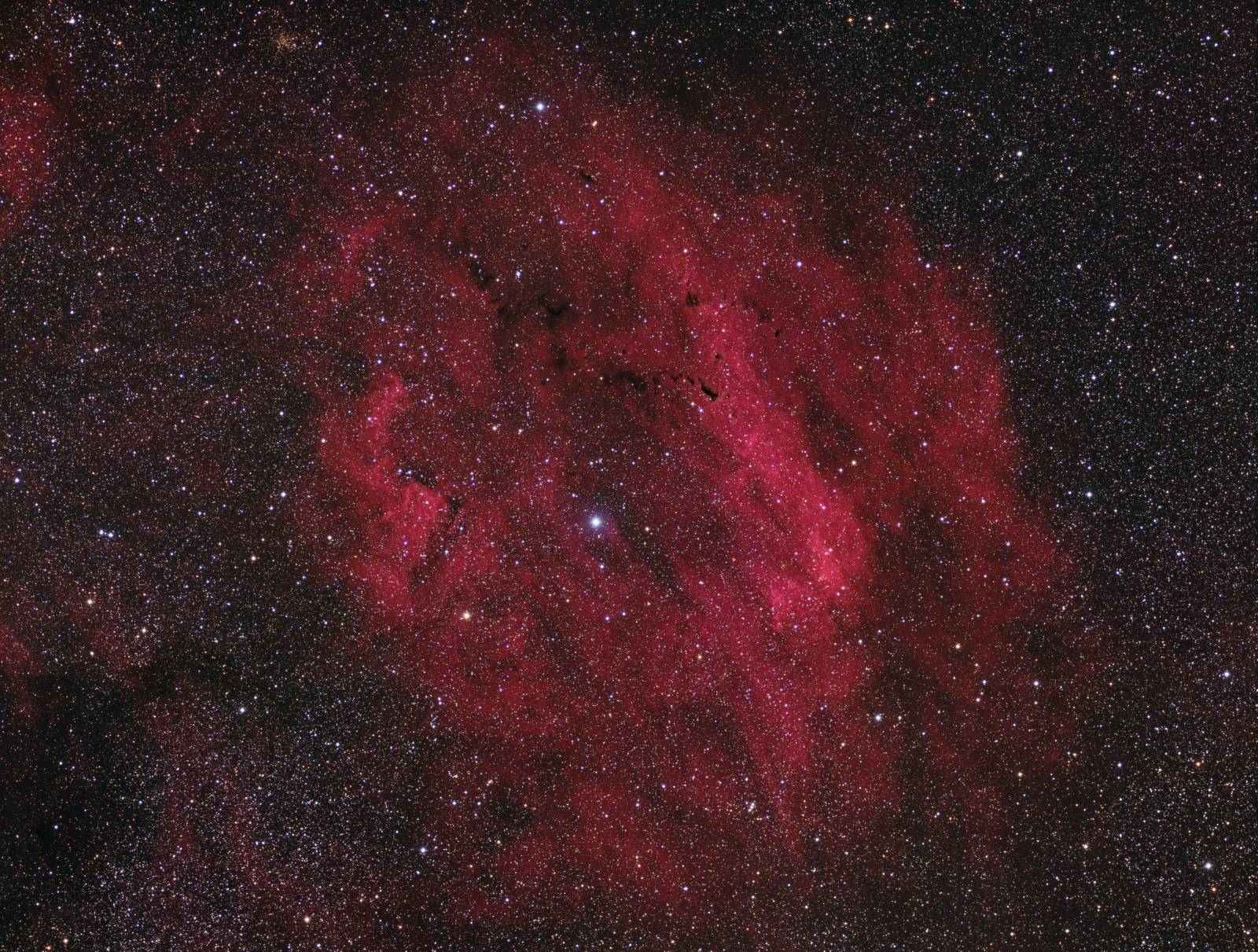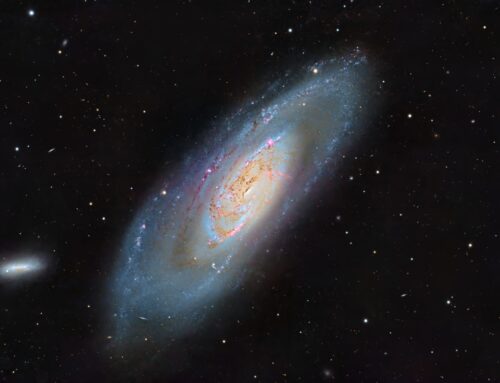Sh2-119
 Click image for full size version
Click image for full size version
July 7, 2017
This large, diffuse emission nebula is Sh2-119 (Sharpless 119). It is a few degrees east of the North America nebula, in Cygnus. This large object contains too many members of the LBN and LDN catalogues to list here (LBN and LDN are Lynd’s Bright Nebulae and Lynd’s Dark Nebulae, respectively). The bright star in the centre is 68-Cygni. Like the North America nebula, this gas cloud is about 1,800 light years away.
I have prepared an annotated image that highlights a number of other interesting objects in this field. Near the top, left of centre is a lovely golden open star cluster, NGC 7044. There are also many galaxies in this field. Although it is difficult to find them in this very crowded field of stars and bright nebulae, the annotated image makes them obvious.
Tekkies:
Moravian G3-16200 EC camera (on loan from O’Telescope), Optolong RGB and 7nm H-alpha filters, Takahashi FSQ-106 ED IV at f/3.6, Paramount MX. Acquisition with the SkyX unguided. Focused with FocusMax. All pre-processing and processing in PixInsight. Acquired from my SkyShed in Guelph. Nearly full moon, good transparency and average seeing.
12x5m R, 18x5m G, 21x5m B and 24x10m Ha unbinned frames (total=12hr30m).
NB-RGB Creation
Creation and cleanup: The BatchPreProcessing script was used to perform calibration, cosmetic correction and registration of all frames. DrizzleIntegration was used to make the channel masters. The R, G, B and Ha masters were cropped to remove edge artifacts. R, G and B were combined to make an RGB image which was processed with DBE, BackgroundNeutralization and ColorCalibration.
Combining Ha and RGB data: The NBRGBCombination script was run with default settings using Ha for red narrowband (scale 1.2). The resulting image was used as the RGB image in a second run of the script with Ha assigned to the blue NB channel (scale 0.01). The two were blended with the first 80% and the second 20% to make the NBRGB image used in all subsequent steps.
Linear Noise Reduction: MultiscaleLinearTransform was used to reduce noise in the NBRGB image. Layer settings for threshold and strength: Layer 1: 5.5, 1.0 Layer 2: 3.5, 0.84 Layer 3: 2.5, 0.71 Layer 4: 1.0, 0.55 Layer 5: 1.5, 0.28 Layer 6: 1.0, 0.16.
Stretching: HistogramTransformation was applied to the NBRGB image to make a pleasing, bright image.
Synthetic Luminance:
Creation and cleanup of SynthL: The linear Ha, R, G and B masters were combined using the ImageIntegration tool (average, additive with scaling, noise evaluation, iterative K-sigma / biweight midvariance, no pixel rejection). DBE was applied.
Deconvolution: A star mask was made to use as a local deringing support image. A copy of the image was stretched to use as a range mask. Deconvolution was applied (50 iterations, regularized Richardson-Lucy, external PSF made using DynamicPSF tool with about 20 stars).
Linear Noise Reduction: MultiscaleLinearTransform was used to reduce noise in the background areas of the NBRGB file. Layer settings for threshold and strength: Layer 1: 3, 0.6 Layer 2: 2.5, 0.44 Layer 3: 2.0, 0.35 Layer 4: 1.0, 0.25 Layer 5: 1.5, 0.18 Layer 6: 1.0, 0.1.
Stretching: HistogramTransformation was applied to the SynthL to make a pleasing, bright image.
Noise Reduction and Re-Stretch: TGVDenoise was applied in Lab mode with 300 iterations with a range mask used to protect high signal areas. This was followed by a HistogramTransformation to raise the black point (but with no clipping).
Combining SynthL with NBRGB:
The processed SynthL was applied to the NBRGB image using LRGBCombine with default settings.
Additional Processing
Contrast Enhancement: The contrast was boosted with 1 passes of LocalHistogramEqualization with max contrast of 1.5 (scale 50, strength 0.25) using a mask to protect background and stars.
Final Steps: Background, nebula and star brightness, contrast and saturation were adjusted in several iterations using Curves with masks as required. The DarkStructureEnhance script was applied (8 layers, strength 0.15) to a copy of the image, which was blended back to the “flatter” parts of the image to accentuate dark features in the nebulae. The hue of the nebula was adjusted slightly with the Curve tool. Image was downsampled to original camera resolution.
Image scale is about 3.2 arcsec per pixel for this camera / telescope combination.






Leave A Comment